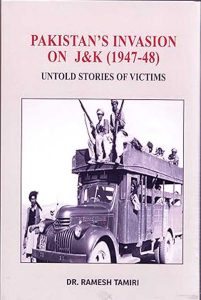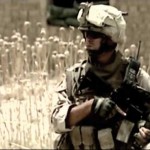
By Dr Ramesh Tamiri, Pages 342, Hardback, Price Rs 995
Distributor Oberoi Book Service, Jammu, Email: Oberoi_jammu@rediffmail.com
This work falls in the category of oral history but with conspicuous differences. It is not a tell-tale story: it is a piece of classical research entailing a stupendous effort of collecting reminiscences of the victims of the Pakistani incursion of J&K in October 1947.
It took the author no fewer than twenty-three years of sustained research to identify the survivors of the holocaust, establish contact with them, fix interviews, and record their story of what catastrophe befell them.
The field research sprang many hurdles, particularly owing to the wide dispersal of the victimized persons throughout the country after the ethnic cleansing of Kashmir of its Hindu population in 1990.
He has interviewed more than 450 of such surviving persons who were either victims or eyewitnesses of the Holocaust . There were others also who had expired but their stories were to be culled out from their close kith and kin and recorded without any discrepancy.
The work begins with a concise but in-depth account of the Pakistani conspiracy to attack the J&K State many months ahead of the partition of the country and the declaration of independence.
It was in the fitness of things that in most cases the collected fund of stories was checked and re-checked from other sources including the secondary ones as well. Inserting a host of photographs of the victims lends great credibility to this rare narrative. Some of the photographs are very rare in historical terms.
The work begins with a concise but in-depth account of the Pakistani conspiracy to attack the J&K State many months ahead of the partition of the country and the declaration of independence. This aspect is either suppressed or unknown to most Kashmir experts. The incursion was planned by the top leadership of the Muslim League-led Pakistan government in connivance with the top echelons of the colonial power structure still holding the charge of crucial administrative or army positions.
The idea of Kashmir incursion originated with the Muslim League think-tank; it received the blessings of the British Governors still in power: the planning and war strategy came from Pakistan Army Generals and manpower was acquired through jihadist appeals made to the tribal lashkars by their chiefs. Therefore, it is wrong to call it a “tribal incursion.”
It was a meticulously planned, precisely focused and efficiently implemented Pakistani attack in which even the smallest detail was taken care of. The routes along which the invading columns would advance were highlighted, the commanders of different contingents were nominated, maps and human guides were provided and winter clothing, and vituals were supplied in plenty to the lashkars for a long stay.
The lashkars were told that they were free to kill the minorities (Hindus and Sikhs), rape and kidnap their women and loot their property as war booty. The succinct presentation of the ingress with which the narrative begins gives a new dimension to the Pakistani plan of incursion. Many nuances of this attack were kept hidden. For example, we did not know that many Muslim officers of Colonel rank in INA were also part of the invading forces.
The left ideologue and poet Faiz Ahmad Faiz, too, was closely associated with the planning of the incursion.
Some communists like Latif Afghani and religious figures like Pir of Manki Sharif played a very active role in executing the attack. All of these actors were motivated by jihadist zeal. The left ideologue and poet Faiz Ahmad Faiz, too, was closely associated with the planning of the incursion.
The story of the massacres of Hindus and Sikhs at numerous places like Muzaffarabad, Domel, Chakar, Mirpur, Bhimbar, Rajouri, Budhal, Chassana, Skardu, Khaplu, Shigar, etc. is so horrendous as to presume that the barbarians were revisiting this part of the earth. Atrocities perpetrated on hapless minorities defy expression. Thousands of them committed suicide by taking poison or jumping into the gushing torrents of Jhelum to escape brutalities and dishonour. Thousands taken prisoners were murdered in cold blood. Hundreds of women were raped and many sold in different cities of Pakistan. A few dozen were rescued by the Red Cross.
While narrating the dreadful stories of the heartless killing of men, women and children, as he came to know from his sources, the author has also mentioned in detail the humanism and kindness demonstrated by numerous Muslims at various places and occasions resulting in rescuing the victims from the jaws of death. One more laudable aspect of the work is that the author has painstakingly carried out his investigation and data collection exercise to almost all the affected towns and localities in different regions of the State.

Dr Ramesh Tamiri, Pages 342, Hardback, Price Rs 995
Distributor Oberoi Book Service, Jammu, Email: Oberoi_jammu@rediffmail.com
The tactics of targeted attacks on the members of religious minorities are almost the same, only the numbers of the victims killed are at variance. Places like Muzaffarabad, Mirpur, Rajouri, Bhimber, etc. where the concentration of the religious minorities was large, suffered the unimaginable brunt of massacre. Over 38,000 people, Hindus and the Sikhs lost their lives in holocausts unleashed by Pakistani invaders.
This work is unique and gives a wholesome picture of what the Hindus and Sikhs of J&K suffered at the hands of Pakistani invaders in Pakistan’s invasion of J&K in 1947-48. This history will explode the bottom of much falsehood spread by Pakistan and biased historians aligned to it.




